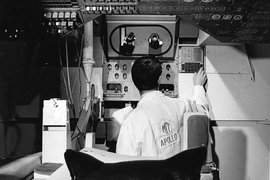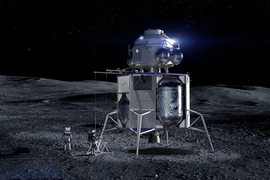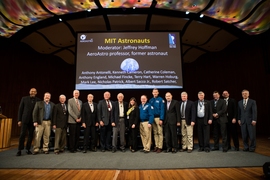In July, the world celebrated the 50th anniversary of the historic Apollo 11 moon landing. MIT played an enormous role in that accomplishment, helping to usher in a new age of space exploration. Now MIT faculty, staff, and students are working toward the next great advances — ones that could propel humans back to the moon, and to parts still unknown.
“I am hard-pressed to think of another event that brought the world together in such a collective way as the Apollo moon landing,” says Daniel Hastings, the Cecil and Ida Green Education Professor and head of the Department of Aeronautics and Astronautics (AeroAstro). “Since the spring, we have been celebrating the role MIT played in getting us there and reflecting on how far technology has come in the past five decades.”
“Our community continues to build on the incredible legacy of Apollo,” Hastings adds. Some aspects of future of space exploration, he notes, will follow from lessons learned. Others will come from newly developed technologies that were unimaginable in the 1960s. And still others will arise from novel collaborations that will fuel the next phases of research and discovery.
“This is a tremendously exciting time to think about the future of space exploration,” Hastings says. “And MIT is leading the way.”
Sticking the landing
Making a safe landing — anywhere — can be a life-or-death situation. On Earth, thanks to a network of global positioning satellites and a range of ground-based systems, pilots have instantaneous access to real-time data on every aspect of a landing environment. The moon, however, is not home to any of this precision navigation technology, making it rife with potential danger.
NASA’s recent decision to return to moon has made this a more pressing challenge — and one that MIT has risen to before. The former MIT Instrumentation Lab (now the independent Draper) developed the guidance systems that enabled Neil Armstrong and Buzz Aldrin to land safely on the moon, and that were used on all Apollo spacecraft. This system relied on inertial navigation, which integrates acceleration and velocity measurements from electronic sensors on the vehicle and a digital computer to determine the spacecraft’s location. It was a remarkable achievement — the first time that humans traveled in a vehicle controlled by a computer.
Today, working in MIT’s Aerospace Controls Lab with Jonathan How, the Richard Cockburn Maclaurin Professor of Aeronautics and Astronautics, graduate student Lena Downes — who is also co-advised by Ted Steiner at Draper — is developing a camera-based navigation system that can sense the terrain beneath the landing vehicle and use that information to update the location estimation. “If we want to explore a crater to determine its age or origin,” Downes explains, “we will need to avoid landing on the more highly-sloped rim of the crater. Since lunar landings can have errors as high as several kilometers, we can’t plan to land too closely to the edge.”
Downes’s research on crater detection involves processing images using convolutional neural networks and traditional computer vision methods. The images are combined with other data, such as previous measurements and known crater location information, enabling increased precision vehicle location estimation.
“When we return to the moon, we want to visit more interesting locations, but the problem is that more interesting can often mean more hazardous,” says Downes. “Terrain-relative navigation will allow us to explore these locations more safely.”
“Make it, don’t take it”
NASA also has its sights set on Mars — and with that objective comes a very different challenge: What if something breaks? Given that the estimated travel time to Mars is between 150 and 300 days, there is a relatively high chance that something will break or malfunction during flight. (Just ask Jim Lovell or Fred Haise, whose spacecraft needed serious repairs only 55 hours and 54 minutes into the Apollo 13 mission.)
Matthew Moraguez, a graduate student in Professor Olivier L. de Weck’s Engineering Systems Lab, wants to empower astronauts to manufacture whatever they need, whenever they need it. (“On the fly,” you could say).
“In-space manufacturing (ISM) — where astronauts can carry out the fabrication, assembly, and integration of components — could revolutionize this paradigm,” says Moraguez. “Since components wouldn’t be limited by launch-related design constraints, ISM could reduce the cost and improve the performance of existing space systems while also enabling entirely new capabilities.”
Historically, a key challenge facing ISM is correctly pairing the components with manufacturing processes needed to produce them. Moraguez approached this problem by first defining the constraints created by a stressful launch environment, which can limit the size and weight of a payload. He then itemized the challenges that could potentially be alleviated by ISM and developed cost-estimating relationships and performance models to determine the exact break-even point at which ISM surpasses the current approach.
Moraguez points to Made in Space, an additive manufacturing facility that is currently in use on the International Space Station. The facility produces tools and other materials as needed, reducing both the cost and the wait time of replenishing supplies from Earth. Moraguez is now developing physics-based manufacturing models that will determine the size, weight, and power required for the next generation of ISM equipment.
“We have been able to evaluate the commercial viability of ISM across a wide range of application areas,” says Moraguez. “Armed with this framework, we aim to determine the best components to produce with ISM and their appropriate manufacturing processes. We want to develop the technology to a point where it truly revolutionizes the future of spaceflight. Ultimately, it could allow humans to travel further into deep space for longer durations than ever before,” he says.
Partnering with industry
The MIT Instrumentation Lab was awarded the first contract for the Apollo program in 1961. In one brief paragraph on a Western Union telegram, the lab was charged with developing the program’s guidance and control system. Today the future of space exploration depends as much as ever on deep collaborations.
Boeing is a longstanding corporate partner of MIT, supporting such efforts as the Wright Brother’s Wind Tunnel renovation and the New Engineering Education Transformation (NEET) program, which focuses on modern industry and real-world projects in support of MIT’s educational mission. In 2020, Boeing is slated to open the Aerospace and Autonomy Center in Kendall Square, which will focus on advancing enabling technologies for autonomous aircraft.
Just last spring the Institute announced a new relationship with Blue Origin in which it will begin planning and developing new payloads for missions to the moon. These new science experiments, rovers, power systems, and more will hitch a ride to the moon via Blue Moon, Blue Origin’s flexible lunar lander.
Working with IBM, MIT researchers are exploring the potential uses of artificial intelligence in space research. This year, IBM’s AI Research Week (Sept. 16-20) will feature an event, co-hosted with AeroAstro, in which researchers will pitch ideas for projects related to AI and the International Space Station.
“We are currently in an exciting new era marked by the development and growth of entrepreneurial private enterprises driving space exploration,” says Hastings. “This will lead to new and transformative ways for human beings to travel to space, to create new profit-making ventures in space for the world’s economy, and, of course, lowering the barrier of access to space so many other countries can join this exciting new enterprise.”









